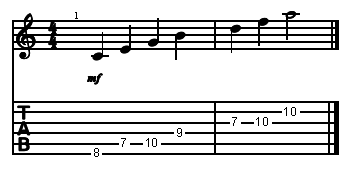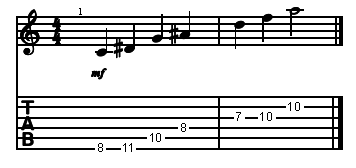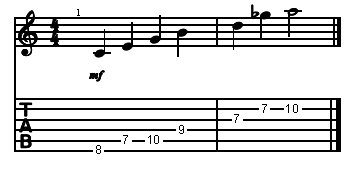Introduction
Arpeggios are an awesome way to bring your solos to life. They will add a melodic appeal to your leads while helping you organize your musical ideas. This article will help you understand better how to use them and how to incorporate them into your musical vocabulary.
Before we dive into the subject, let’s define what an arpeggio is. Simply put, an arpeggio is a series of notes played one after the other that highlight the notes of a chord. In that regards, arpeggios are intimately linked to the scales they are extracted from.
Principle of Harmonization
Let’s talk a little it about harmonization. Harmonization is a way to organize notes so that they create non clashing harmonious sounds. The easiest way to do this is to pick every other note from any given scale. This will create a non clashing sound as the notes won’t be too close to each other while played together.
Let’s take a simple example using a C Major scale: C - D - E - F - G - A - B
Let’s build a harmonious three note chord. We’ll pick the root (C) and add to it every other note of the scale until we have a three note chord: C - E - G.
Playing these three notes together will give us a three note chord also called “triad.” This triad can be played as an arpeggio by simply playing these notes one after the other as follows:

If we look at the way this looks on a scale diagram, we will have something similar to this (the square notes being the triad built on the C Major scale):
 Four Note Arpeggios
Four Note Arpeggios
The same exact technique can be used to create more complex arpeggios such as four notes arpeggios. Let’s take the same C Major scale and build a four note arpeggio. We will get the following notes: C - E - G - B.


This gives us a richer sounding arpeggio. The more notes found in an arpeggio, the more useful information you are giving your listener as to which key you are playing in. Triads and Four notes arpeggios are very common in modern music. They are a great resource when it comes to establishing a musical color and are a wonderful tool to create melodic leads. So why not applying the idea to create richer arpeggios?
Ionian Arpeggio
Before we can build more complex arpeggios, we need to talk a bit about how to map out a scale across our fretboard. We’ve been using a seven note scale. Those notes are mapped out as follow: Root - 2nd - 3rd - 4th - 5th - 6th - 7th.
After the seventh, the notes simply repeat themselves an octave higher. Let’s now map out our scale over two octaves. Notice how the higher octave notes are called:
Root - 2nd - 3rd - 4th - 5th - 6th - 7th
Octave - 9th - 10th - 11th - 12th - 13th - 14th
This allows us to build up to seven notes arpeggios as follows: Root - 3rd - 5th - 7th - 9th - 11th - 13th.
Let’s take a look at the tablature and diagram for such an arpeggio:


We now have a very rich sounding arpeggio that uses all seven notes of the scale we extracted it from. This arpeggio including all notes of the scale will give the listener all the need information to know which key you are playing in. In this particular case we are in C Major. We’ll call this arpeggio an Ionian arpeggio (Ionian is another name for Major scale).
We can apply the same technique to build seven notes arpeggios over any given scale.
Dorian Arpeggio
Let’s try to build a seven note arpeggio over a Dorian scale. First let’s take a look at the formula of the Dorian scale: Root - 2nd - min3rd - 4th - 5th - Maj6th - min7th.
To build a seven note arpeggio, we need to extend the scale in a two octave range:
Root - 2nd - min3rd - 4th - 5th - Maj6th - min7th
Octave - 9th - 10th - 11th - 12th - 13th - 14th
This allows us to build our arpeggio as follows:

 Phrygian Arpeggio
Phrygian Arpeggio
Let’s now work with the Phrygian scale. First let’s take a look at the formula of the Phrygian scale: Root - min2nd - min3rd - 4th - 5th - min6th - min7th.
To build a seven note arpeggio, we need to extend the scale in a two octave range:
Root - 2nd - min3rd - 4th - 5th - Maj6th - min7th
Octave - 9th - 10th - 11th - 12th - 13th - 14th
This allows us to build our arpeggio as follows:

 Lydian Arpeggio
Lydian Arpeggio
Let’s now build a seven note Lydian arpeggio. Here is the formula of the Lydian scale: Root - 2nd - 3rd - #4th - 5th - 6th - Maj7th.
To build a seven note arpeggio, we need to extend the scale in a two octave range:
Root - 2nd - 3rd - #4th - 5th - 6th - Maj7th
Octave - 9th - 10th - #11th - 12th - 13th - 14th
This allows us to build the following arpeggio:

 Mixolydian Arpeggio
Mixolydian Arpeggio
Let’s now build a Mixolydian arpeggio. Here is the formula of the Mixolydian scale: Root - 2nd - 3rd - 4th - 5th - 6th - min7th.
To build a seven note arpeggio, we need to extend the scale in a two octave range:
Root - 2nd - 3rd - 4th - 5th - 6th - min7th
Octave - 9th - 10th - 11th - 12th - 13th - min14th
This allows us to build the following arpeggio:

 Aeolian Arpeggio
Aeolian Arpeggio
We’ll now build an arpeggio over a Aeolian scale. Here is the formula of the Aeolian scale: Root - 2nd - min3rd - 4th - 5th - min6th - min7th.
To build a seven note arpeggio, we need to extend the scale in a two octave range:
Root - 2nd - min3rd - 4th - 5th - min6th - min7th
Octave - 9th - 10th - 11th - 12th - min13th - 14th
This allows us to build our arpeggio as follows:

 Locrian Arpeggio
Locrian Arpeggio
Last but not least, let’s take a look at a Locrian arpeggio. First let’s take a look at the formula of the Locrian scale: Root - min2nd - min3rd - 4th - b5th - min6th - min7th.
To build a seven note arpeggio, we need to extend the scale in a two octave range:
Root - 2nd - min3rd - 4th - b5th - Maj6th - min7th
Octave - 9th - 10th - 11th - b12th - 13th - 14th
This allows us to build our arpeggio as follows:

 Conclusion
Conclusion
If you followed the steps previously described, you shouldn’t have any problems developing new musical ideas using some of these arpeggios. These arpeggios can be used as “skeletons” to build your improvisations on. You could for example use the notes of the arpeggios as resting blocks. Try building new licks off of the previous diagrams and remember to keep things musical.
Practice well!